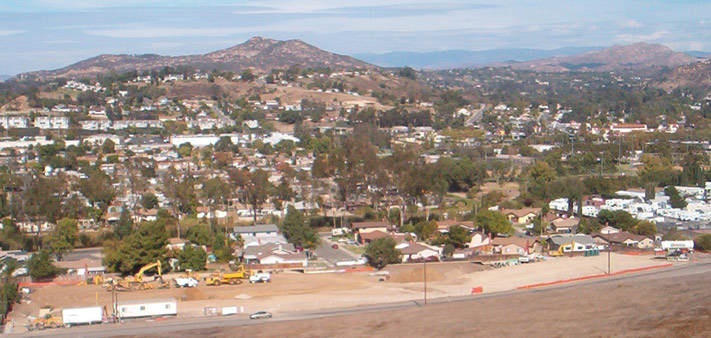
Metate Meadows
Poway, California 92064
by Derrick Garbell
 |
Metate Meadows |
12920 Metate Lane Poway, California 92064 |
A Powegian's Perspective by Derrick Garbell |
"Metate Meadows" is a low income housing project sponsored by the City of Poway through The Metate Meadows property was acquired in November, 2004 from the family that owned the Starlight Stables, for $4.5 million. It covers four acres, abuts the Poway Royal Estates mobile home park to the east, and to the south it faces the Tustin Hills dedicated open space below the Stowe Drive sector of the Poway Business Park. On the west and north it is surrounded by single family homes built between 1960-1970, including the Tustin Hills subdivision. On 3 August 2005, Ingrid Alverde, the Redevelopment Agency's Housing Program Manager, announced that Metate Meadows would be developed with between 33-40 single family homes on lot pads of approximately 4,500 sq. ft. each, and the homes would be sold, not rented. The selling of redevelopment housing was a first in Poway's history. The Redevelopment Agency's prior projects included Haley Ranch Estates (prefabricated, detached SFR homes), Hillside Village (townhouse homes), and Solara (apartments), and they had all been for lease or rent only. Alverde said the City was looking for a development partner for planning and design, and that search plus securing construction financing would take twelve to twenty-four months overall. This would be followed by a year of construction. Alverde estimated that occupancy of the completed project would be two to three years, between August 2007 and August 2008 at the outside. The project continually changed design over time, and by spring 2008, its format was quite different. Rather than build 33-40 detached homes, the decision was made to build 30 houses, with only 2 detached, and 28 as twin-homes. Many citizens complain that the City Council and RDA do not shepherd these projects efficiently enough, greatly lengthening their development time frame. As a result, the City must pay far greater holding costs before recouping its investment; Poway's tax payers bear these costs. With the City facing budget shortages, these protracted redevelopment expenditures are a sizable component of municipal waste and indebtedness. Construction concluded in November, 2009, taking 13 months from grading to completion. But by December 31, 2009 only five of the 30 homes were sold. |
||
| Photos from the first six months of construction. As of April 17, 2009, less than half the foundations have been poured: | ||
| "Fact Sheet" from the City, preparatory to public hearings; the area enclosed in yellow triangle was marked incorrectly by the RDA; it fails to encompass the main, western area of the project, causing several Tustin Hills residents to mistakenly conclude that Metate Meadows would not abutt their properties.Thus they were duped into not submitting objections to the impact this would have on their views and neighborhood density. | The eventual site plan showing 30 homes, 28 as twin duplex models. |
|
| SD Union article October, 2004 | North County Times article Ag07 | promotional brochure pdf |
| initial grading - view from Reo Real 1Nv2008 | project panorama 1Nv08 #1 from south | project panorama 1Nv08 #2 from south |
| western foundation pads 17Ap09 | overview of the first pads fronting Metate Ln with Rick St & Orpah to the west |
slabs from Metate Ln looking west 17Ap09 |
| main entrance to Metate Meadows, aligns with Reo Real, formerly a culdesac |
eastern foundation pads, looking westward | short panorama movie of Metate Meadows 17 April 2009 |
| short pan of skyline above Metate Meadows - from Twin Peaks Mountain due north, to Mt. Woodson, northeast | ||
| Construction progess 20 June 2009, looking south from old Reo Real: | ||
| February 2011: six and half years after property acquisition many units remain unsold, carrying costs being paid by Poway City taxpayers: | ||
| panoramic view of Metate Meadows facing north February 2011 | short panorama movie of Metate Meadows Feb 2011 | |
| February 2012: seven and half years after property acquisition three units remain unsold, carrying costs still being paid by Poway City taxpayers | ||
| our town dimly Fb12 | ||
| © Derrick Garbell & All Rights Reserved | ||